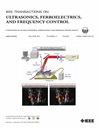脉冲高强度聚焦超声疗法中瞬态空化气泡成像的动态模式分解。
IF 3
2区 工程技术
Q1 ACOUSTICS
IEEE transactions on ultrasonics, ferroelectrics, and frequency control
Pub Date : 2024-04-10
DOI:10.1109/TUFFC.2024.3387351
引用次数: 0
摘要
脉冲高强度聚焦超声(pHIFU)可以在不引入外源性造影剂的情况下诱导稀疏的新生惯性空化,促进靶组织的轻度机械破坏。由于气泡很小,而且在每个 HIFU 脉冲之后会迅速溶解,因此绘制瞬时气泡图并获得与组织损伤相关的实时定量指标具有挑战性。之前的工作引入了气泡多普勒,这是一种超快功率多普勒成像方法,是绘制空化气泡的灵敏手段。该方法的主要局限是依赖于多普勒成像中使用的传统壁滤波器,并针对血流而非瞬态散射体成像进行了优化。本研究利用多普勒集合矩阵的动态模式分解(DMD)来探索气泡多普勒增强,以绘制和提取瞬态空化气泡的特征。首先利用模拟组织和气泡反向散射信号时空特征的数值数据集对 DMD 进行了模拟测试。将 DMD 滤波器的性能与其他广泛使用的多普勒壁滤波器--奇异值分解(SVD)和无限脉冲响应(IIR)高通滤波器--进行了比较。然后将 DMD 应用于体外组织数据集,其中每个 HIFU 脉冲之后都会立即出现平面波多普勒集合。硅学中 DMD 的性能优于 SVD 和 IIR 高通滤波器,而体内外数据则提供了与气泡相关的模式及其相应的时间衰减率的物理可解释图像。使用 k-means 聚类方法可以跟踪 pHIFU 治疗过程中的这些 DMD 模式,从而得出治疗进展的量化指标。本文章由计算机程序翻译,如有差异,请以英文原文为准。
Dynamic Mode Decomposition for Transient Cavitation Bubbles Imaging in Pulsed High-Intensity Focused Ultrasound Therapy
Pulsed high-intensity focused ultrasound (pHIFU) can induce sparse de novo inertial cavitation without the introduction of exogenous contrast agents, promoting mild mechanical disruption in targeted tissue. Because the bubbles are small and rapidly dissolve after each HIFU pulse, mapping transient bubbles and obtaining real-time quantitative metrics correlated with tissue damage are challenging. Prior work introduced Bubble Doppler, an ultrafast power Doppler imaging method as a sensitive means to map cavitation bubbles. The main limitation of that method was its reliance on conventional wall filters used in Doppler imaging and its optimization for imaging blood flow rather than transient scatterers. This study explores Bubble Doppler enhancement using dynamic mode decomposition (DMD) of a matrix created from a Doppler ensemble for mapping and extracting the characteristics of transient cavitation bubbles. DMD was first tested in silico with a numerical dataset mimicking the spatiotemporal characteristics of backscattered signal from tissue and bubbles. The performance of DMD filter was compared to other widely used Doppler wall filter-singular value decomposition (SVD) and infinite impulse response (IIR) high-pass filter. DMD was then applied to an ex vivo tissue dataset where each HIFU pulse was immediately followed by a plane wave Doppler ensemble. In silico DMD outperformed SVD and IIR high-pass filter and ex vivo provided physically interpretable images of the modes associated with bubbles and their corresponding temporal decay rates. These DMD modes can be trackable over the duration of pHIFU treatment using k-means clustering method, resulting in quantitative indicators of treatment progression.
求助全文
通过发布文献求助,成功后即可免费获取论文全文。
去求助
来源期刊
CiteScore
7.70
自引率
16.70%
发文量
583
审稿时长
4.5 months
期刊介绍:
IEEE Transactions on Ultrasonics, Ferroelectrics and Frequency Control includes the theory, technology, materials, and applications relating to: (1) the generation, transmission, and detection of ultrasonic waves and related phenomena; (2) medical ultrasound, including hyperthermia, bioeffects, tissue characterization and imaging; (3) ferroelectric, piezoelectric, and piezomagnetic materials, including crystals, polycrystalline solids, films, polymers, and composites; (4) frequency control, timing and time distribution, including crystal oscillators and other means of classical frequency control, and atomic, molecular and laser frequency control standards. Areas of interest range from fundamental studies to the design and/or applications of devices and systems.

 求助内容:
求助内容: 应助结果提醒方式:
应助结果提醒方式:


